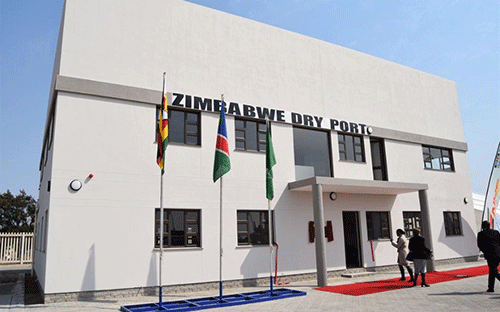Namibia is working with the government of Zimbabwe to rehabilitate the railway line between the two countries to boost the movements of goods following the operationalisation of the Zimbabwe Dry Port at Walvis Bay. The dry port was opened by President Hage Geingob and his Zimbabwean counterpart, Emmerson Mnangagwa, in July 2019.
Although Zimbabwe is a landlocked country, it has access to the Atlantic Ocean via the Port of Walvis Bay because of the 50-year lease of a 1.8 hectare dry port facility. The dry port is anticipated to provide a strategic and cost-effective avenue to the Atlantic Ocean for Zimbabwean manufacturers and international businesses.
According to Zimbabwean officials, the dry port will boost regional and intra-African trade.
“The two ministries of transport and infrastructure development in Zimbabwe and works and transport in Namibia are discussing the improvement of the railway lines linking Zimbabwe and Namibia so that we rehabilitate or improve the railway line. We feel that it will be a cheaper mode than road, but we will use both,” noted Amos Marawa, Zimbabwe’s deputy chief secretary and national coordinator responsible for programmes and projects in the Office of the President. He added that the idea is to boost business between the two countries that already have solid bilateral relations.
The rail connectivity with Namibia will be linked with a railway line from Hwange in Zimbabwe. Even goods destined for Zimbabwe from the dry port are expected to be transported by the railway linking the two countries.
Namibian ambassador to Zimbabwe, Nicklaas Kandji, recently observed that the dry port provided an opportunity to link Zimbabwe to “facilitate exports to Europe, West Africa and America”.
In collaboration with the Walvis Bay Corridor Group, Zimbabwe’s dry port management has embarked on aggressive marketing in source and consumer markets to propel growth. The Walvis Bay Corridor serves as an alternative to link Zimbabwe to Europe, North America as well as South America, and through Walvis Bay, local importers and exporters can save more than 10 days in transit time to these markets.
Zimbabwean imports and exports have an option either to use the Trans-Kalahari Corridor or Trans-Caprivi Corridor as the trade corridor linkage.
Recent reports indicate Zimbabwe’s Dry Port facility is operating at between 65% and 70% of capacity due to a lack of support from the Zimbabwean business community. The facility is managed by Zimbabwe’s National Handling Services (NHS). The facility currently manages mostly vehicles, of which 90% to 98% are destined for Zimbabwe, with the remaining cars sent to the regional markets for countries such as Zambia and Malawi.
“We had quite a lot of timber, which was destined for Vietnam and other Far East countries. We are looking at handling perishable products as well as frozen products. We are looking at close to between 200 and 350 vehicles per month. As for the timber that we handled last time, it was around 500 tonnes. The local business community and the diaspora have been urged to fully utilise the facility.


